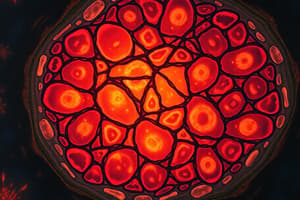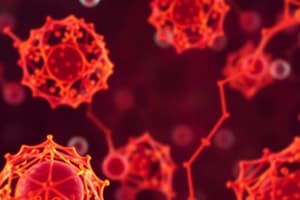Podcast
Questions and Answers
What role do cyclins play in the cell cycle?
What role do cyclins play in the cell cycle?
- They pause cell cycle progression when conditions are unfavorable.
- They regulate the G1-S transition without involvement of Cdks.
- They are present in constant levels throughout the cell cycle.
- They activate cyclin-dependent kinases to promote cell cycle advancement. (correct)
What is the primary function of the protein p53 in the cell cycle?
What is the primary function of the protein p53 in the cell cycle?
- To ensure the continuous movement of the cell cycle without interruptions.
- To detect DNA damage and halt the cell cycle when necessary. (correct)
- To activate cyclin-dependent kinases for cell cycle progression.
- To promote apoptosis under all circumstances.
Which of the following best describes negative regulation of the cell cycle?
Which of the following best describes negative regulation of the cell cycle?
- It utilizes only cyclins for ensuring the timely completion of the cycle.
- It enhances the availability of cyclins to promote faster division.
- It guarantees that all cells proceed through the cycle simultaneously.
- It involves proteins that can interrupt the cycle when there are issues. (correct)
How do cyclin-dependent kinases (Cdks) contribute to cell cycle regulation?
How do cyclin-dependent kinases (Cdks) contribute to cell cycle regulation?
Which statement correctly describes the relationship between Rb and the cell cycle?
Which statement correctly describes the relationship between Rb and the cell cycle?
What is the primary function of tumor suppressor genes?
What is the primary function of tumor suppressor genes?
Which syndrome is characterized by an extra copy of chromosome 21?
Which syndrome is characterized by an extra copy of chromosome 21?
What type of genetic disorder results from nondisjunction?
What type of genetic disorder results from nondisjunction?
What is a common symptom of Turner Syndrome?
What is a common symptom of Turner Syndrome?
Which genetic disorder is associated with a deletion of a portion of chromosome 5?
Which genetic disorder is associated with a deletion of a portion of chromosome 5?
What is the main characteristic feature of Triple X Syndrome?
What is the main characteristic feature of Triple X Syndrome?
What is a notable symptom of Patau Syndrome?
What is a notable symptom of Patau Syndrome?
What genetic mechanism leads to Down Syndrome?
What genetic mechanism leads to Down Syndrome?
What is the primary reason phospholipids form bilayers in water?
What is the primary reason phospholipids form bilayers in water?
In the Fluid-Mosaic Model, what does the term 'fluidity' refer to?
In the Fluid-Mosaic Model, what does the term 'fluidity' refer to?
Which of the following statements best describes biological membranes?
Which of the following statements best describes biological membranes?
What characteristic of bilayers contributes to their ability to form closed vesicles?
What characteristic of bilayers contributes to their ability to form closed vesicles?
Which component is NOT typically part of the Fluid-Mosaic Model?
Which component is NOT typically part of the Fluid-Mosaic Model?
What is the primary function of the sodium-potassium pump?
What is the primary function of the sodium-potassium pump?
Which process is characterized by the movement of large molecules such as proteins?
Which process is characterized by the movement of large molecules such as proteins?
Secondary active transport differs from primary active transport in that it relies on which of the following?
Secondary active transport differs from primary active transport in that it relies on which of the following?
What defines the symport mechanism in secondary active transport?
What defines the symport mechanism in secondary active transport?
During exocytosis, what happens to the materials within the vesicle?
During exocytosis, what happens to the materials within the vesicle?
Which statement correctly describes phagocytosis?
Which statement correctly describes phagocytosis?
What is a characteristic of primary active transport?
What is a characteristic of primary active transport?
Which of the following is NOT a function of active transport?
Which of the following is NOT a function of active transport?
What is the primary function of the cell membrane?
What is the primary function of the cell membrane?
Which of the following best describes the structural composition of phospholipids in the cell membrane?
Which of the following best describes the structural composition of phospholipids in the cell membrane?
Which type of membrane protein is primarily involved in signaling between cells?
Which type of membrane protein is primarily involved in signaling between cells?
How do membrane proteins facilitate cell-to-cell recognition?
How do membrane proteins facilitate cell-to-cell recognition?
What is one consequence of low testosterone in males with Klinefelter Syndrome?
What is one consequence of low testosterone in males with Klinefelter Syndrome?
Which type of transport mechanism requires energy to move substances?
Which type of transport mechanism requires energy to move substances?
What physical characteristic is commonly associated with Jacobs Syndrome?
What physical characteristic is commonly associated with Jacobs Syndrome?
Which component primarily prevents the cell membrane from being permeable to water?
Which component primarily prevents the cell membrane from being permeable to water?
What happens during the process of passive transport across the membrane?
What happens during the process of passive transport across the membrane?
What is a typical treatment for individuals with Klinefelter Syndrome?
What is a typical treatment for individuals with Klinefelter Syndrome?
In Klinefelter Syndrome, what physical feature is commonly observed?
In Klinefelter Syndrome, what physical feature is commonly observed?
What role do cholesterol molecules play in the cell membrane?
What role do cholesterol molecules play in the cell membrane?
Which feature of integral membrane proteins differentiates them from peripheral proteins?
Which feature of integral membrane proteins differentiates them from peripheral proteins?
Which of the following is NOT a common symptom of XYY Syndrome?
Which of the following is NOT a common symptom of XYY Syndrome?
Flashcards are hidden until you start studying
Study Notes
Regulating The Cell Cycle
- Positive Regulation:
- Drives progression of the cell cycle. Examples: Cyclins and cyclin-dependent kinases (Cdks).
- Cyclins fluctuate, activating Cdks which phosphorylate proteins, promoting cell cycle progression.
- Negative Regulation:
- Pauses the cell cycle when needed. Examples: Retinoblastoma protein (Rb), p53, and p21.
- p53 detects DNA damage and can trigger apoptosis.
- Rb regulates the G1-S transition, blocking cell cycle progression until specific conditions are met.
Mitotic Diseases: Cancer
- Proto-oncogenes:
- Normal genes that code for positive cell-cycle regulators.
- When mutated, they become oncogenes which can lead to cancer.
- Example: Cdk protein.
- Tumor suppressor genes:
- Normal genes that code for negative cell-cycle regulatory proteins.
- Prevent uncontrolled cell division.
- Example: p53. When mutated, they lose their tumor suppressor activity, increasing the risk of cancer.
Meiotic Diseases
- Nondisjunction:
- Failure of chromatids to separate during anaphase I and II of meiosis, leading to an imbalance of chromosomes in daughter cells.
- Causes various genetic disorders.
Trisomy 21
- Common Name: Down syndrome.
- Cause: An extra copy of chromosome 21.
- Symptoms: Distinct facial features, including a flattened face, small ears, upward-slanting eyes, and a small mouth.
Cat-Cry Syndrome
- Common Name: Cri du Chat (French for "cry of the cat").
- Cause: Deletion of a portion of the short arm of chromosome 5.
- Symptoms: High-pitched, cat-like cry in infancy, microcephaly (small head size).
Monosomy X
- Common Name: Turner Syndrome.
- Cause: Missing or incomplete X chromosome in females.
- Symptoms: Short stature, delayed puberty, infertility, ovarian failure, webbed neck, broad chest, and low-set ears.
Trisomy 18
- Common Name: Edwards Syndrome.
- Cause: An extra copy of chromosome 18.
- Symptoms: Low birth weight, clenched fists, overlapping fingers, small jaw, and malformed feet (rocker-bottom feet).
Trisomy 13
- Common Name: Patau Syndrome.
- Cause: An extra copy of chromosome 13
- Symptoms: Cleft lip or palate, extra fingers or toes (polydactyly).
Trisomy X
- Common Name: Triple X Syndrome.
- Cause: Extra X chromosome in females.
- Symptoms: Increased risk of early ovarian failure and infertility.
XXY Syndrome
- Common Name: Klinefelter Syndrome.
- Cause: Extra X chromosome in males.
- Symptoms: Low testosterone, reduced facial and body hair, infertility, small testes, delayed puberty, breast development (gynecomastia), learning disabilities.
XYY Syndrome
- Common Name: Jacobs Syndrome.
- Cause: Extra Y chromosome in males.
- Symptoms: Increased risk of behavioral issues, such as ADHD.
Cell Membrane
- Primary Function: Regulates what goes in and out of the cell.
- Other Functions: Separates the cell from the outside world and defines it as a distinct entity.
- Structures:
- Phospholipids:
- Basic fabric of the plasma membrane.
- Arranged in a bilayer.
- Amphipathic:
- Hydrophilic regions: Head of the bilayer, water-loving, faces outward.
- Hydrophobic regions: Tail of the bilayer, water-fearing, faces inward.
- Proteins:
- Second major component of the plasma membrane.
- Integral membrane proteins: Embedded within the membrane.
- Peripheral membrane proteins: Associated with the surface of the membrane.
- Phospholipids:
Functions of Membrane Proteins
- Intercellular Joining: Form junctions between adjacent cells and serve as anchoring points for cytoskeletal elements.
- Active or Passive Transport: Move substances across the membrane.
- Active transport: Moves molecules against their concentration gradient, requiring energy.
- Passive transport: Moves molecules down their concentration gradient, no energy required.
- Anchoring: Anchor the cell to its substrate.
- Signal Transduction: Receive information from other cells.
- Cell-to-Cell Recognition: Serve as identification tags for other cells to recognize.
- Enzymatic Activity: Catalyze reactions.
Relationship of Cell Membrane Structure to Its Function
- Phospholipids form bilayers in water: Amphipathic nature of phospholipids allows them to form a bilayer structure in water, with hydrophilic heads facing outward and hydrophobic tails facing inward.
- The Fluid-Mosaic Model explains Membrane Structure: Membranes are dynamic and fluid, composed of various components, including phospholipids, proteins, carbohydrates, and cholesterol.
- Biological Membranes are two-dimensional fluids: Components of the membrane can move laterally within the bilayer.
- Biological Membranes fuse and form closed vesicles: Membranes can form self-sealing vesicles, allowing for transport of materials into and out of the cell.
Active Transport: Relevance
- Nutrient Uptake: Active transport brings nutrients into the cell.
- Waste Removal: Active transport removes waste products from the cell.
- Ion Balance: Active transport maintains ion balance across the cell membrane.
Types of Active Transport
- Primary Active Transport: Directly uses ATP to transport molecules against their concentration gradient. Example: Sodium-potassium pump (Na⁺/K⁺-ATPase).
- Secondary Active Transport: Uses the energy from the electrochemical gradient created by primary active transport.
- Symport: Molecules move in the same direction across the membrane.
- Antiport: Molecules move in opposite directions across the membrane.
Bulk Transport
- Movement of large molecules, such as proteins and polysaccharides, in groups.
- Two processes: Endocytosis and Exocytosis.
Bulk Transport: Exocytosis
- Process of removing materials from the cell through vesicles that fuse with the plasma membrane, releasing contents outside the cell.
Bulk Transport: Endocytosis
- Cells engulf materials.
- The substance is enclosed in a vesicle and brought into the cytoplasm.
- Phagocytosis: Engulfing of undissolved materials.
- Pinocytosis: Engulfing of dissolved substances.
Studying That Suits You
Use AI to generate personalized quizzes and flashcards to suit your learning preferences.




